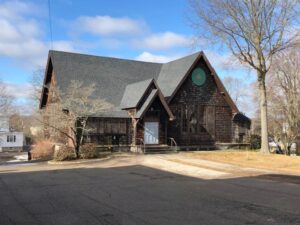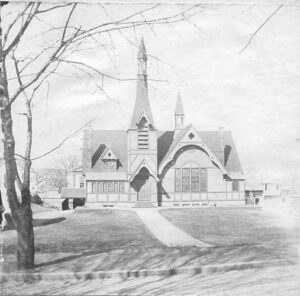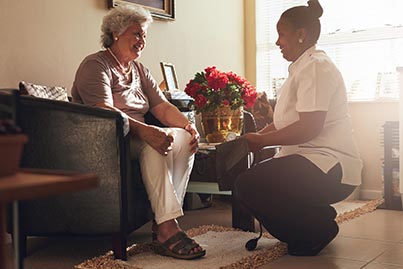The Elms Blog
The Girl Scout House
Note: The “Girl Scout House” as it is popularly known, is located directly across the street from The Elms. Guy Maiorano, founder and CEO of The Elms, formerly owned The Girl Scout House.
To look at it today, you’d never know that the dilapidated brown shingle building that was once the Girl Scout House at 23 Elm Street in Westerly was originally a beautiful church with spires, stained glass windows and many ornate touches. It was, until the Girl Scouts of Southeastern New England acquired it in 1948, home to the Calvary Baptist Church. And for the next 50 years, hundreds — perhaps thousands — of young Girl Scouts attended regular meetings there.
 When the building first opened as the Calvary Baptist Church in April,1875, the newly built structure featured a bell tower and steeple centered above the building’s main entrance, while a smaller spire sat just behind it and to the right (see photos). “The original church was a half-Tudor building featuring exposed timbers infilled with smooth painted boards” and wood roof shingles, architect Meg Lyons stated in a re-use study commissioned by the current owners, the Royce Family Fund. “Ten-foot-tall windows graced the east, south, and west facades, flooding the interior with light. Each of the gables had carved bargeboards with quatrefoil openings, creating a deep overhang that shadowed the façade.” Circular windows on each gable peak, called oriels, may have contained stained glass, as did the front-facing windows of the church. It was, she said, “a building with charm and character.”
When the building first opened as the Calvary Baptist Church in April,1875, the newly built structure featured a bell tower and steeple centered above the building’s main entrance, while a smaller spire sat just behind it and to the right (see photos). “The original church was a half-Tudor building featuring exposed timbers infilled with smooth painted boards” and wood roof shingles, architect Meg Lyons stated in a re-use study commissioned by the current owners, the Royce Family Fund. “Ten-foot-tall windows graced the east, south, and west facades, flooding the interior with light. Each of the gables had carved bargeboards with quatrefoil openings, creating a deep overhang that shadowed the façade.” Circular windows on each gable peak, called oriels, may have contained stained glass, as did the front-facing windows of the church. It was, she said, “a building with charm and character.”
The building also stood out because it was set so far back on its lot: the structure sits more than 100 feet from the street, down a gentle slope.
The main sanctuary, a space measuring 30 by 48 feet, features a vaulted ceiling with elegant carved wooden arches that intersect in the center of the room. At each intersection, called a groin vault, wooden pendants hang down from the center points. Each truss also features a decorative cut-out in the shape of a quatrefoil, a Christian symbol consisting of four overlapping circles that looks like a four-leaf clover. The lower sanctuary walls are still clad with wainscot paneling, with plaster above, and tall paneling surrounds the raised stage area where the pulpit would have been located.
The ground floor includes a small kitchen and a large open room, with wooden floors over a dirt crawlspace. Large pocket doors with painted glass panes were designed to be pulled across to split the room into two smaller meeting spaces.
Today the spires are gone, as is the stained glass and fancy trim, which may have been removed by the Girl Scouts after the organization purchased the building as a meeting place for the burgeoning number of troops in the area. A photo from 1951 shows that the siding had been replaced with wooden shingles, and the oriel in front was covered with the Girl Scout trefoil logo, a gold clover on a green background that a local sign maker created from a sketch drawn by Betty Cugini, who was a Girl Scout in the 1940s, went on to become president of the Rhode Island Council in the ‘80s, and worked in the organization for more than 50 years.
 “We think it was the Girl Scouts who made the changes to the building,” says Meg Lyons, the architect retained by the current owners, the Royce Family Fund, to preserve and rehabilitate the property. “The Girl Scouts removed any religious items from the building,” says Lyons. “They may have also removed the steeple.”
“We think it was the Girl Scouts who made the changes to the building,” says Meg Lyons, the architect retained by the current owners, the Royce Family Fund, to preserve and rehabilitate the property. “The Girl Scouts removed any religious items from the building,” says Lyons. “They may have also removed the steeple.”
But Cugini thinks it more likely that the church removed the spires and other religious ornamentation before giving it to the Girl Scouts. “I don’t think the Girl Scouts would have had the money to remove the steeples,” she says, adding that she doesn’t recall ever seeing the spires on the building. “I was a kid at the time, but I don’t remember it,” Cugini says.
Whoever made the changes it’s evident that, by 1951, when the building was dedicated as The Westerly Girl Scout House, those renovations had already taken place, as evidenced by a photo of the House that appeared in the October 31, 1951, issue of the The Providence Evening Bulletin.
Providing Safe, Comfortable, and Empowered Lifestyles
Enjoy the charm of victorian architecture, spacious and relaxing community rooms and outdoor spaces, a vibrant and historic downtown and local community, and award-winning care that is always close at hand.


